
Botrychium is a genus of ferns, seedless vascular plants in the family Ophioglossaceae. Botrychium species are known as moonworts. They are small, with fleshy roots, and reproduce by spores shed into the air. One part of the leaf, the trophophore, is sterile and fernlike; the other, the sporophore, is fertile and carries the clusters of sporangia or spore cases. Some species only occasionally emerge above ground and gain most of their nourishment from an association with mycorrhizal fungi.
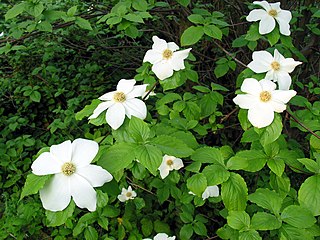
Cornus nuttallii, the Pacific dogwood,western dogwood, or mountain dogwood, is a species of dogwood tree native to western North America.
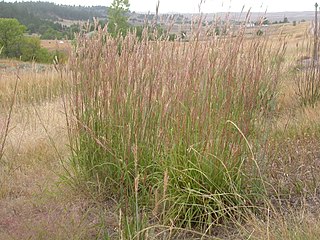
Andropogon gerardi, commonly known as big bluestem, is a species of tall grass native to much of the Great Plains and grassland regions of central and eastern North America. It is also known as tall bluestem, bluejoint, and turkeyfoot.
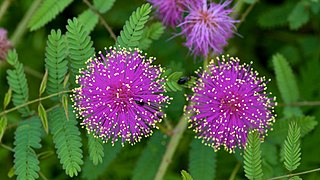
Mimosa nuttallii, the Nuttall's sensitive-briar, catclaw brier, or sensitive brier, is an herbaceous perennial legume in the subfamily Mimosoideae native to the central United States. It has a trailing semi-woody vine covered with small recurved prickles that can be painful to bare skin.
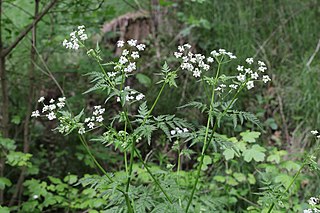
Anthriscus sylvestris, known as cow parsley, wild chervil, wild beaked parsley, Queen Anne's lace or keck, is a herbaceous biennial or short-lived perennial plant in the family Apiaceae (Umbelliferae), genus Anthriscus. It is also sometimes called mother-die, a name that is also applied to the common hawthorn. It is native to Europe, western Asia and northwestern Africa. It is related to other diverse members of Apiaceae, such as parsley, carrot, hemlock and hogweed. It is often confused with Daucus carota, another member of the Apiaceae also known as "Queen Anne's lace" or "wild carrot".
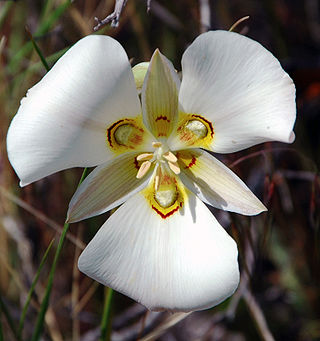
Calochortus nuttallii, also known as the sego lily, is a bulbous perennial plant that is endemic to the Western United States. It is the state flower of Utah.
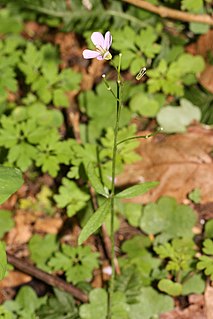
Cardamine nuttallii is a species of cardamine known by the common name Nuttall's toothwort. It is native to western North America from British Columbia to California, where it grows in moist mountain habitats.

Leptosiphon nuttallii is a species of flowering plant in the phlox family known by the common name Nuttall's linanthus.
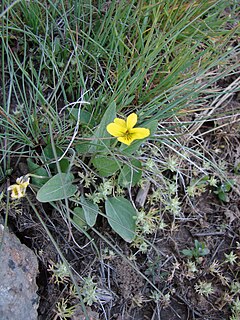
Viola nuttallii is a perennial herbaceous plant in the violet family (Violaceae), and is one of the few violet species with lanceolate leaves. It is native to the western Canada and the north-central and western United States, appearing in upper steppe lands, forests, and alpine ridges.

Torilis japonica, the erect hedgeparsley, upright hedge-parsley or Japanese hedge parsley, is a herbaceous flowering plant species in the celery family Apiaceae. Japanese hedge parsley is considered both an annual and biennial plant depending on the biogeographical location. This means Japanese hedge parsley can complete its life cycle in either one or two growing seasons depending on habitat. Japanese hedge parsley is typically found in areas with disturbed soils, pastures, margins, open woodland, near waste sites, or right-of-way habitats. It can withstand a variety of habitats, thriving in partial and full shaded areas, but also withstanding habitats with full sunlight penetration. It is considered an aggressive invasive species in North America; invading a wide range of habitats due to its environmental tolerance and tendency to outcompete native vegetation. This species is considered a threat in several areas that causes problems relating to overall environmental health and stability. Aside from its environmental implications, T. japonica has potential to fight several cancers through a terpene it produces called Torilin, extracted from its fruits.

Dalea candida is a species of flowering plant in the legume family known by the common name white prairie clover. It is native to North America, where it can be found throughout central Canada, the central United States, and northern Mexico. It can sometimes be found outside its range as an introduced species. It grows in many types of habitat, including several types of prairie, foothills, woods, forests, and disturbed areas.

Torilis arvensis is a species of flowering plant in the family Apiaceae known by the common names spreading hedgeparsley, tall sock-destroyer and common hedge parsley. It is native to parts of Europe and it is known elsewhere, such as North America, as an introduced species and a common weed. It grows in many types of habitat, especially disturbed areas. It is an annual herb producing a slender, branching, rough-haired stem up to a meter in maximum height. The alternately arranged leaves are each divided into several pairs of lance-shaped leaflets up to 6 centimeters long each. The leaflet is divided or deeply cut into segments or teeth. The inflorescence is a wide open compound umbel of flower clusters on long, slender rays. Each flower has five petals which are unequal in size and are white with a pinkish or reddish tinge. Each greenish or pinkish fruit is 3 to 5 millimeters long and is coated in straight or curving prickles.

Lyonia lucida is a species of flowering plant in the family Ericaceae known by the common names fetterbush lyonia, hurrahbush, and staggerbush. Other plants may also be called fetterbush. This broadleaved evergreen plant grows on the coastal plain of the southeastern United States from Virginia to Florida to Louisiana. It also occurs in Cuba.
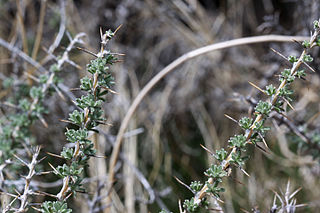
Tetradymia nuttallii is a species of flowering plant in the aster family known by the common name Nuttall's horsebrush. It is native to the western United States, where it occurs in Nevada, Utah, Wyoming, and Colorado.

Lespedeza capitata is a species of flowering plant in the Fabaceae, or legume family, and is known by the common name roundhead bushclover, or roundhead lespedeza. It is native to eastern North America, including eastern Canada and the eastern half of the United States.

Atriplex nuttallii, also known as Nuttall's saltbush, is native to central and western North America. It has been treated by some botanists as a synonym of Atriplex canescens.

Toxicoscordion nuttallii is a species of poisonous plant native to the south-central part of the United States.

Polygala senega is a species of flowering plant in the milkwort family, Polygalaceae. It is native to North America, where it is distributed in southern Canada and the central and eastern United States. Its common names include Seneca snakeroot, senega snakeroot, senegaroot, rattlesnake root, and mountain flax. Its species name honors the Seneca people, a Native American group who used the plant to treat snakebite.

Polytaenia texana, commonly known as Texas prairie parsley, is a species of flowering plant in the carrot family (Apiaceae). It is native to Texas and Oklahoma in the United States.
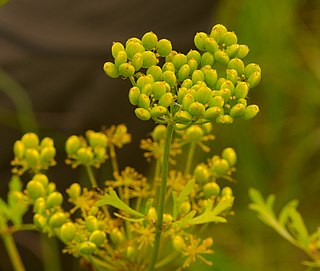
Polytaenia is a genus of flowering plants belonging to the family Apiaceae.





















